
|
Jan 25, 2012
Shale Opponents Turning Science Into Farce
GWPF
The academic face of the anti-fracking movement - Cornell marine ecologist Robert Howarth - increasingly looks like he’s willing to turn science into farce.
Last spring, the once-obscure professor became the go-to expert for anti-fracking journalists and lawmakers when he published a report claiming shale gas pollutes more than coal. The New York Times featured his study in two uncritical articles in one week, he was interviewed on dozens of talk shows - and the media echo chamber did the rest: He was a star.
Since then, other scientists have almost universally challenged his findings - but now he’s doubled down.
Last week, Howarth released another scientifically questionable study, now warning that fracking could push the world over a tipping point, sending temperatures irreversibly higher - an inflammatory and demonstrably incorrect assertion.
Here’s the backstory. Shale gas is acknowledged as an ideal “bridge fuel” to a cleaner energy future. It’s become cost-attractive thanks to fracking: a proven extraction technique used for decades, technologically tweaked to mine shale gas - notably the Marcellus Formation beneath a large swath of New York.
Thanks to fracking, America is poised to transform itself from a fuel pauper, dependent upon the whims of Mideast madmen and Russian oligarchs, into an energy exporter.
But hard leftists have always opposed any energy other than wind or solar. That’s where Howarth and the anti-fracking Park Foundation come in.
In an interview, Howarth told me his goal was to make the anti-fracking movement mainstream and fashionable. He said he met with the Ithaca-based foundation two years ago, agreeing to produce a study challenging the conventional wisdom that shale gas is comparatively clean.
The polluting impact of shale gas revolves around one key issue: how much methane gas is released during extraction. Methane has more short-term global-warming impact than any other fossil fuel. Howarth emerged from academic nowhere when he claimed shale-gas wells leak like sieves, venting methane half the time, spewing 7 percent to 8 percent of reserves into the atmosphere.
“That’s absurd,” says Michael Levi, director of the Program on Energy Security and Climate Change at the Council of Foreign Relations. “Most methane gas is either “delivered to sales” with no leakage, or it’s burnt off through flaring, which diminishes its greenhouse impact.”
Renowned geologist Lawrence Cathles, also at Cornell, who published a scathing deconstruction of Howarth’s paper this month, says that he “doesn’t document venting but what the industry calls ‘capture.’”
Almost every independent researcher - at the Environmental Defense Fund, the Natural Resources Defense Council, the Energy Department and numerous independent university teams - has slammed Howarth’s conclusions. At a minimum, the evidence suggests he either acted in bad faith or is ignorant of gas technology.
The core problem: Howarth uses Environmental Protection Agency estimates dating to 2007 - ancient data, given how quickly the technology is evolving.
Crucially, he fails to account for innovation. Gas lost through leakage is money lost, literally into thin air. For that reason, new wells are now “green completed” - meaning most leaking gas is captured and sold rather than vented.
Cathles notes the latest Devon study, now being verified by the EPA, documenting that shale gas is vented in only 5 percent of wells. The Energy Department estimates only 1 percent to 2 percent of methane is now lost during production.
Bottom line, almost all nonindustry-linked researchers believe Howarth exaggerates the impact of shale-gas leakage by 10 to 20 times. “His conclusions are more a politically charged articulation than a balanced scientific assessment,” Cathles says.
Howarth hired an aggressive PR firm, the Hastings Group, to promote his politicized viewpoint. Scientists aren’t buying it, but many journalists fall for the fear-mongering.
Howarth doesn’t have to convince anyone he’s right to devastate New York’s budding shale industry and put tens of thousands of jobs into question. He wins if he muddies the waters enough to give cautious Albany bureaucrats reason to stall.
Almost every news story now frames this issue as a standoff between equally valid scientific experts. In fact, it’s really a debate between science and ideology.
Jon Entine is a senior research fellow at the Center for Health & Risk Communication at George Mason University/STATS.
Jan 23, 2012
Forecastthefacts.org - Political Activists Gagging Our TV Meteorologists on Climate Issues
By Michael A. Lewis, PhD. and Anthony Watts
Some one or some organization is attempting to influence the upcoming annual meeting of the American Meteorological Society (AMS).
According to WCTV-TV’s story Urging American Meteorological Society to Get Tougher on Climate Change, a program called Forecast the Facts is attempting to lobby the AMS to change their 5-year policy on climate change to a new policy “drafted by a panel of [unidentified] experts” (emphasis added).
A new campaign, Forecast the Facts (www.forecastthefacts.org), launches Sunday to pressure TV meteorologists to inform their viewers about climate change. The launch coincides with the kick-off of the American Meteorological Society’s (AMS) annual meeting in New Orleans, LA.
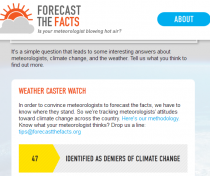
Enlarged.
“This is an important moment in the history of the AMS,” said Daniel Souweine, the campaign’s director. “It’s well known that large numbers of meteorologists are climate change deniers. It’s essential that the AMS Council resist pressure from these deniers and pass the strong statement currently under consideration.”
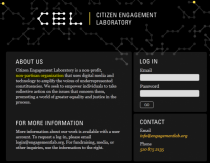
The “Campaign Director” is identified as Daniel Souweine. The Forecast the Facts web site turns out to be a product of “Citizen Engagement Laboratory (CEL).”
And who is the Chief of Staff of CEL? You guessed it: Daniel Souweine. Here’s his Facebook page.
The web site describes CEL as: “a non-profit, non-partisan organization that uses digital media and technology to amplify the voices of underrepresented constituencies. We seek to empower individuals to take collective action on the issues that concern them, promoting a world of greater equality and justice in the process.”
But as we see elsewhere, in the green incubator building description of CEL at the David Browner Center at 2150 Allston Way, Berkeley, CA, that “non-partisan” claim doesn’t match this description:

So much for the “truth in advertising”.
They also go to trouble to obfuscate their website domain, here is the WHOIS results for forecastthefacts.org and .com:

Interesting thing though, is that when you check to see what other web servers are at the same domain IP address, you discover a whole flock of political activist websites.
READ MUCH MORE AND SPREAD THE WORD.
UPDATE: Forecastthefacts.org (operated by Citizen Engagement Lab) is a George Soros funded activist website. Here’s the proof (h/t to WUWT reader Jan). See.
Jan 21, 2012
Time to get greens off the backs of Africans
by Cyril Boynes, Jr. (Congress of Racial Equality)
While on extended leave in New York, I often pondered conditions in this huge city, versus in Uganda and most of Africa. Perhaps most of all, I reflected on electricity and the economic activity, modern living standards and improved health that this amazing technology makes possible. I thought about that as I read articles about climate change “reparations” and other foreign aid, oil and gas discoveries in Africa, and impediments to African electricity and economic development.
Several European and US energy companies recently announced major natural gas discoveries in East Africa, both onshore and offshore. Other companies are using hydraulic fracturing to unlock natural gas from the continent’s shale rock formations.
There is a lot of talk about building LNG (liquefied natural gas) terminals to ship gas overseas. “I’m convinced that in 10 years’ time Tanzania, Mozambique and Kenya will together form a major gas hub for Asian and Far Eastern markets,” Cove Energy CEO John Craven told the Wall Street Journal.
There is a lot of gas in West Africa too, especially in Angola and Nigeria, and companies are often criticized for “flaring” gas - burning it off at the wellhead, instead of using it for something productive. (The same thing happened in the United States, until people figured our how to use this previously unwanted byproduct of oil production to heat homes, generate electricity, and make fertilizers, plastics and chemicals.)
Why should this valuable energy resource be flared? In fact, why should we just talk about sending it to Asia, the Far East and other markets? Why aren’t we talking more about using it right here in Africa?
Why aren’t we talking more about using it right here in Africa?
East African gas could easily be used all over the Great Lakes region to generate electricity for homes and businesses, hospitals and schools, jobs and economic growth - turning dreams into reality. All we’d need to do is provide legal, tax and other incentives to attract investors who could build a few gas-fired generating plants and pipelines to connect them to gas fields.
There would still be plenty of gas for export, but the reliable, affordable electricity would launch an economic boom unlike anything we have ever seen.
That’s what happened in the southeastern United States, when the Tennessee Valley Authority began building hydroelectric dams and other projects. One of America’s poorest regions was transformed into an economic powerhouse. Dams built in the Southwest and Pacific Northwest regions of the USA during the Great Depression did the same thing.
Recognizing the immense value of electricity, South Africa is racing to build the Medupi coal-fired power plant and many other generators and transmission lines. In just one example, when an electrical line finally reached a remote area of the country, two furniture makers were able to install power equipment, hire local workers, sell far more furniture of much higher quality - and help launch a local economic revolution that has enabled families to improve their living standards greatly.
Just imagine what could happen if people all over Africa could have access to affordable electricity, 24 hours a day, 365 days a year!
Meanwhile, Ghana is building a 130-MW gas-fired power plant, even though the US Overseas Private Investment Corporation refused to support the $185-million project. Other investors stepped forward, the plant is being built, the country will send some of its abundant natural gas to the plant, and numerous Ghanaians will finally enjoy the blessings of modern living through electricity.
Just imagine what could happen if people all over Africa could have access to affordable electricity, 24 hours a day, 365 days a year!
As Zambian Dambisa Moyo and South African Leon Louw have often said, foreign aid causes more harm than good- whether it is traditional aid or new-fangled “climate reparation” aid. Most of it ends up in just a few hands. Poor families see little or no improvement in their lives. And people have few incentives and little money to make investments, launch businesses or improve their homes and communities.
Foreign aid keeps people alive, but barely. It ties them to international welfare, in perpetual poverty, with little or no chance to become middle class.
Let them eat cake!
Access to electricity changes everything. It puts people in charge of their future. It unleashes the human spirit, and people’s innovative and entrepreneurial instincts. It gives people one of the most important tools they need: affordable, reliable energy for lights, refrigerators, computers and machinery - along with good jobs, so that they can afford electricity, more nutritious food, healthcare and other basics.
Some say putting more carbon dioxide into the air from burning natural gas will affect the climate. However, many scientists say CO2 plays only a minor role in climate change - and Africans already put millions of tons into the air by burning wood, grass and dung, which are far less efficient fuel sources and cannot generate electricity.
The rest of the world - especially Europeans, Americans, Chinese and Indians – are burning enormous amounts of coal and natural gas to generate the electricity that runs their countries. Why shouldn’t Africa? Besides, carbon dioxide makes plants grow better, even in droughts, and companies like General Electric are developing cleaner, more efficient gas turbine technologies that African nations could purchase.
Kenya, Uganda and other African countries would not need extensive gas pipeline systems. They just need to build a few pipelines to carry gas to large generating units that would provide electricity for homes, hospitals, schools, shops, factories and water treatment plants. Miracles would happen.
As my wife, businesswoman and fellow malaria and economic development activist Fiona Kobusingye, has pointed out, “Not having electricity means millions of Africans die every year from lung infections, because they have to cook and heat with open fires; from intestinal diseases caused by spoiled food and unsafe drinking water; from malaria and other diseases that we could prevent or treat if we had proper medical facilities.”
All that would change if our countries had electricity.
The modern world runs on electricity. It’s time for Africa to take its rightful place among the healthy and prosperous nations of the world. Our growing supplies of natural gas could help make that happen.
Cyril Boynes, Jr. is co-chairman of the Congress of Racial Equality - Uganda.
Jan 19, 2012
The Icelandic Saga Continues
By Paul Homewood
Just to recap, we have learnt that GISS temperatures for Iceland and Greenland have been artificially adjusted, with the result that current temperatures appear much warmer than when compared with the warm period during the 1940’s. Temperature data for Reykjavik from the Iceland Met Office confirmed that this adjustment was wholly artificial and resulted in a net warming of about a half a degree centigrade since 1940 and that the actual mean temperatures in the last decade are about a degree less than GISS show.
I also have data from the Iceland Met Office for two other stations, Stykkisholmur and Akureyri and these show the same pattern of adjustments as the graphs below illustrate.
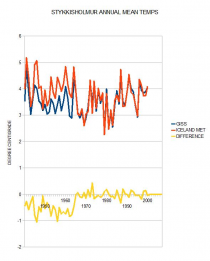
Enlarged.
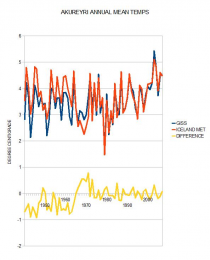
Enlarged.
In both cases the temperatures from 1940 to 1964 have been adjusted downwards, and as with Reykjavik the overall effect is to create about a half a degree of warming.
On further investigation, it appears that the adjustments have actually been carried out by GHCN, whose figures GISS use. The changes seem to have taken place when they issued a revised version, 3.1, of their database in November 2011. The GHCN website gives access to all their stations and shows both adjusted and unadjusted data. Examination of these records confirms that, out of eight stations in Iceland, seven have had such artificial warming applied, e.g
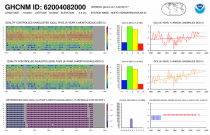
Enlarged.
The top right hand graph (red) is the unadjusted version, middle one is adjusted, and the bottom one graphs the adjustment (blue is minus, red plus).
Evidence is already building up that these adjustments are not limited to only Iceland. Similar adjustments have already been found in Greenland, Ireland and Scotland.
This issue raises several points of concern :-
1) These are palpably not “one-off” adjustments, which might be justified for station location changes or other local reasons. Have they been made as a result of a deliberate decision by GHCN, or are they the result of an error or a faulty piece of software?
2) If the result of error, what does this tell us about the quality control procedures at GHCN and GISS?
3) How many other similar adjustments have been made previously that have not been spotted? Would these have been uncovered without the attention of independent observers?
4) If GHCN believe the adjustments are justified, why have they not published their results and reasons for discussion, before issuing the revision? According to their CHANGELOG “GHCNMv3.1.0 is released with several minor corrections and a reworking of internal arrays for more efficient operations.” No mention of large scale temperature adjustments!
5) What assurance do we have that more changes of this sort won’t be made in future?
Jan 16, 2012
La Ninas (and global cooling) may abet flu pandemics
By Richard Black, BBC
La Nina events may make flu pandemics more likely, research suggests.
US-based scientists found that the last four pandemics all occurred after La Nina events, which bring cool waters to the surface of the eastern Pacific.
In Proceedings of the National Academy of Sciences (PNAS), they say that flu-carrying birds may change migratory patterns during La Nina conditions.
However, many other La Nina events have not seen novel flu strains spread around the world, they caution.
So while the climatic phenomenon may make a pandemic more likely, they say, it is not sufficient on its own - and may not be necessary either.
La Nina is the cold cousin of El Nino - the two collectively making up the El Nino Southern Oscillation (ENSO).
“Certainly ENSO affects weather and precipitation and humidity around the world,” said Jeffrey Shaman from Columbia University in New York.
“But the effects are very varied around the world - there’s no coherent picture.”
Nevertheless, the last four pandemics - the Spanish Flu that began in 1918, the Asian Flu of 1957, the Hong Kong Flu of 1958 and the swine flu of 2009 - were all preceded by periods of La Nina conditions.
What pandemics have in common is that they all feature novel strains of the virus to which people have not developed immunity.
Typically these are created when two existing strains infecting an animal such as a bird or a pig exchange genetic material.
The link to La Nina events is not clear. But recent research has shown that some wild birds’ patterns of flights and stopovers during migrations, or moulting times, differ between El Nino and La Nina years.
“Our best guess is this brings together birds [in La Nina conditions] that don’t otherwise mix, and that allows the genetic reassortment to take place,” Professor Shaman told BBC News.
Yet the fact that many other La Nina periods have not been followed by a pandemic indicate that other factors must also be involved.
If the swine flu pandemic of 2009-10 was part of this pattern, the crossing of viral strains must have had something to do with birds as well as pigs.
As wild migratory birds will sometimes visit farms and as domestic flocks of ducks or chickens often live alongside pigs, especially in developing countries, this is quite feasible.
Professor Shaman cautions that the link is far from being firm enough that it could be used as a tool to forecast pandemics.
NOTE: BACK IN 2009, Eugenio Hackbart of our friends at the METSUL reported on ICECAP that finding:
“..all the flu pandemics in the last 100 years originated in periods of negative PDO and cooling...”
Eugenio Hackbart, METSUL
Our chief meteorologist at MetSul Weather Center Eugenio Hackbart wrote an article, in Portuguese, to the ABC Sunday newspaper that was published on August 28th, calling the attention of the readers to the fact that all the flu pandemics in the last 100 years originated in periods of negative PDO and cooling trend in the world. There were the following pandemics:
Spanish Flu: 1918-1920
Asian Flu: 1957-1958
Hong Kong Flu: 1968-1969
Swine Flu: 2009-
Note that the coldest period of the PDO in the 20th century - 1946 to 1976 - recorded two flu pandemics. Also note that currently we are under the longest streak of months of negatives values for the PDO since late 60’s, exactly when there was the last pandemic prior to the current one. It is very interesting to plot in the PDO graphic the years the flu pandemics originated. MetSul understands that, if climate in fact plays a role, more frequent La Nina events (cold years) and not El Nino episodes have a role to favor flu pandemics.
|
|
|
|









